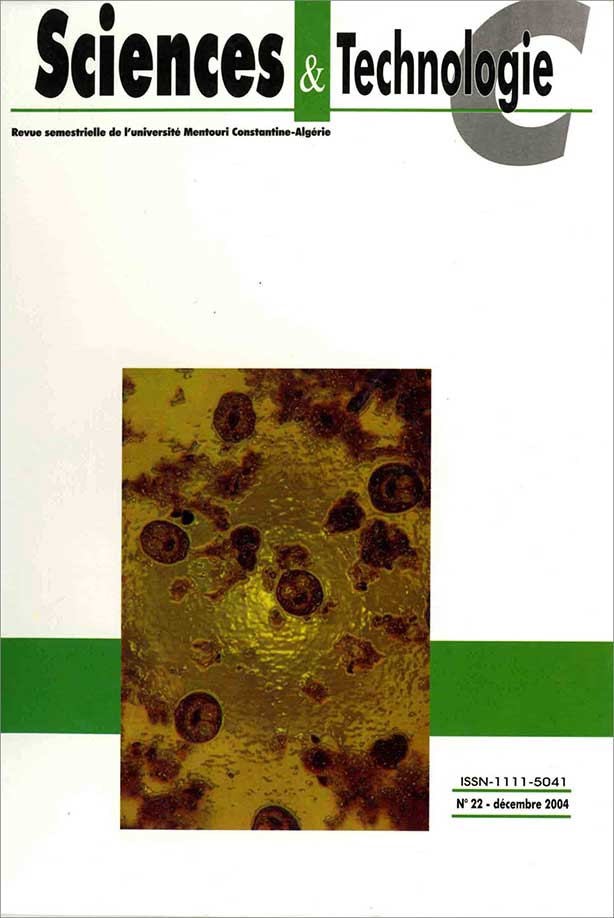EXPRESSION DE LA NOSYNTHASE 2 ET PRODUCTION DU MONOXYDE D’AZOTE (NO) AU COURS DE L’HYDATIDOSE
Keywords:
Hydatidosis, cystic echinococcosis, NOSynthase 2 (NOS2), nitric oxide (NO), leukocytes, peripheral blood monocellular cells (PBMC)Abstract
La production in-vivo de NO au cours de l’hydatidose est évaluée par dosage des nitrites selon la méthode de Griess modifiée dans 74 sérums de patients porteurs de kystes de localisations diverses et 13 sérums de donneurs sains. Les résultats désignent le NO comme mécanisme de défense potentiel de l’hôte vis-à-vis d’Echinococcus granulosus. Cette production également observée dans le liquide hydatique impliquerait une diffusion du NO dans l’hydatide. Des sources cellulaires supplémentaires à celles décrites par notre équipe (leucocytes, PBMC) expliqueraient les teneurs relativement élevées observées. Ces données sont confirmées par la mise en évidence de la présence de la NOS2 inductible dans les hépatocytes de patients atteints d’hydatidose hépatique par des tests immuno-histochimiques utilisant un anticorps anti-NOS2.
References
- Touil-Boukoffa C., "Etude du système interféron et cytokines au cours de l'hydatidose humaine. Implication de l'IFN gamma, du TNF alpha, de l'Il-6 et du NO dans la réponse immunitaire anti-antigène 5", Thèse Doctorat es Sciences / Bioch. Immunopath, ISN- USTHB, (1998).
- Cardozo G., Tucci P. & Hernلndez A., "Characterization of the immune response induced by a carbohydrate enriched fraction from Echinococcus granulosus protoscoleces in patients with cystic hydatid disease", Parasitology Research, Vol. 88, 11, (2002), pp. 984 - 990
- Zhang W., Li J. & McManus D.P., "Concepts in Immunology and Diagnosis of Hydatid Disease", Clinical Microbiology Reviews, January 2003, Vol. 16, 1, (2003), pp. 18-36
- Sennequier N. & Vadon le Goff S., "Biosynthèse du monoxyde d'azote : mécanisme, régulation et contrôle", Med. Sci., 14, (1998), pp. 1185-1195.
- Drapier J.C., "Monoxyde d'azote et macrophages", Path. Biol., 45 (2), (1997), pp. 110-114.
- Dugas-Paul-Eugène N., Mossalayi D., Sarfati M., Yamaoka K., Aubry J.P., Bonnefoy J.Y., Dugas B. & Kolb J.P., "Evidence for a role of FCεRII / CD23 in the Il-4 induced NO production by mononuclear phagocytes", Cellular Immunology, 163, (1995), pp. 314-318.
- Vouldoukis I., Riveros-Moreno V., Dugas B., Ouaaz F., Debré P., Moncada S. & Mossalayi D.M., "The killing Leishmania major by human macrophages is mediated by NO induced after ligation of the FCεRII/CD23 surface antigen", Proc. Nat. Aca. Sci. USA, 92, (1995), pp. 7804-7808.
- Nüssler A.K., Eling W. & Kremsner P.J., "Patients with Plasmodium falciparum malaria and Plasmodium vivax malaria show increased nitrite and nitrate plasma levels", J. Infect. Dis., 169, (1994), pp. 18-19.
- Antsey N.M., Weinberg J.B., Hassalany M.Y., Mwaïkambo E.D., Manyanga D., Mysukonis M.A., Arnelle R.D., Hottis , D., Mc Donald M.L. & Granger D.L., "Nitric oxide in Tanzanian children Malaria : Inverse relationship between malaria severity and nitric oxide production / NOS2 expression", J. Exp. Med, 184, (1996), pp. 557-567.
- Bertholet S. & Mauel J., "Human monohydric U937 cells transfected with human hepatic inducible NOS exhibit leishmanicidal activity", J. Leuc. Biol., 67, 1, (2000), pp. 34-39.
- Rigano R., Profumo E., Ioppolos S., Notargiacomo S., Teggi A. & Siracusano A., "Serum cytokine detection in the clinical follow-up of patients with cystic echinococcosis", Clin. Exp. Immunol., 115 (3), (1998), pp. 503-507.
- Ischiropoulos H., Zhu L. & Beckman J., "Peroxynitrite formation from macrophage derived nitric oxide", Arch. Biochem. Biophys., 298, (1992), pp. 446-451.
- Nozais J.P., Datry A. & Danis M., Traité de Parasitologie médicale. Ed. Pradel, (1997).
- Rippert C., "Epidémiologie des maladies parasitaires- Helminthiases", Ed. Med. Int. 3ème Edition, Tome II, (1998), pp. 277-309.
- Groeneveld P.H.P., Kwappenberg K.M.C., Langermans J.A.M., Nibbering P.T. & Curtis L., "Relation between pro and anti-inflammatory cytokines and the production of NO in sever sepsis", Cytokine, Vol. 9, 2, (1997), pp. 131-142.
- Everklioglu C., Turkoz Y., Er H., Inaloz H.S., Ozbek E. & Cekmen M., "Increased nitric oxide production in patients with Behcet's disease. Is it a new activity marker?", J. Acad. Dermatol., 46, 1, (2002), pp. 50-54
- Touil-Boukoffa C., Bauvois B., Sanceau J., Hamrioui B. & Wietzerbin J., "Production of NO in human hydatidosis relationship between nitrite production and interferon gamma levels", Biochimie, 80, (1998), pp. 739-744.
- Zhang J. & Snyder H., "Nitric oxide in the nervous system", Ann. Pharmacol. Toxicol., 35, (1995), pp. 213-233.
- Nüssler A.K., Berger H.G., Liew Z.Z. & Billiar T.R., "Nitric oxide, hepatocytes and inflammation", 63rd Forum of Immunology, (1996), pp. 671-677.
- Cesbron J.Y. Capron M.& Capron A., "Le diagnostic de l'hydatidose humaine", Gastro-Enterol. Clin. Biol., 10, (1986), pp. 415-418.
- Nüssler A.K., Drapier J.C., Renia L., Pied S., Miltgen S., Gentilini M. & Mazier D., "L-Arginine dependant destruction of intrahepatique malaria parasites in response to tumour necrosis factor and/or Il-6 stimulation", Eur. J. Immunology, 21, (1991), pp. 227-230.
- Mellouk S., Hoffman S.L., Liu Z.Z., De la Vega P., Billiar T.R. & Nussler A.K., "Nitric oxide mediated antiplasmodial activity in human and murine hepatocytes induced by IFN gamma and the parasite it-self : enhancement by exogenous tetrahydrobiopterine", Infect. Immunol., 62, (1994), p. 4043.
- Kolb H. & Kolb-Bachofen V., "Nitric oxide in autoimmune disease, cytotoxic or regulatory mediator?" Immunology Today, Vol. 19, n°12, (1998), p. 556.
- Kolb J.P., "Mechanisms involved in the pro and anti-apoptotic role of NO in human leukemia", Leukemia, 14, 9, (2000), pp. 1685-1694.
- Wietzerbin J., "Interférons et cytokines : Rapport 2000", INSERM, Unité U365- Institut Curie, Paris, (2000).
- Kolb J.P., Paul-Eugène-Dugas N., Yamaoka K., Mossalyi M.D. & Dugas B., "Role of CD23 in NO production by human monocytic cells", 63rd Forum in Immunology, (1996), pp. 684-688.

